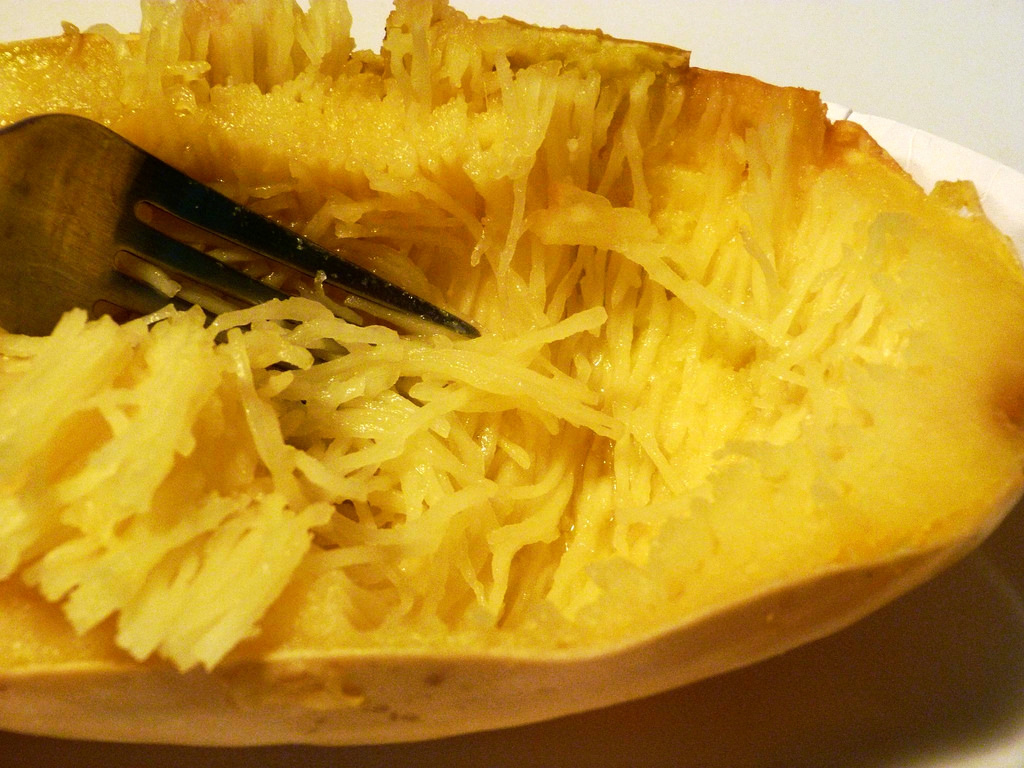By Morgan Crawford, Recent ASU Nutrition Student
We made it to October! With the scorching, Arizona heat almost behind us, fall is in sight. Get ready for pumpkin spice, hot apple cider, and sweater weather. Fall is by far my favorite season and I look forward to the food that comes with it. Though spaghetti squash is considered a “winter squash,” it is most commonly associated with the autumn months.

This special crop made its debut nearly 10,000 years ago in Mexico, where it was discovered to be an excellent source of nutrition. The meaning of the term squash is “eaten raw or uncooked,” which comes from the Native American word, askutasquash. Though this gourd has its origins in Mexico, it is grown primarily in India and China, with the United States importing the highest number of the crop each year.
As someone who is passionate about health and wellness, the nutritional aspect of food is what really gets me excited! From anti-inflammatory properties to high levels of vitamins and minerals, spaghetti squash has so much to offer in terms of nutritional benefits. Here is a list created by well- known natural health physician, Dr. Mercola.
- Eye and skin health
Vitamin A is associated with improved eye health, and cell regeneration.
- Wound healing
Vitamin C, a promotes the production of collagen within the body, which attributes to faster cell reproduction that leads to quick healing. Additionally, this vitamin improves immune response, prevents heart disease, and is thought to even fight certain cancers.
- Free radical fighter
Antioxidants that occur naturally in fruits and vegetables fight against and prevent cell damage in the body.
- Bone health
Calcium is required for several functions within the body, including muscle and nerve function, as well as vascular and hormonal function. Bone health, though, is most heavily influenced by calcium levels. Because 99% of calcium is stored within the bones, it is crucial for everyone to have an adequate amount of calcium in their diet.
- High in Folate
Folate is a type of B vitamin and is vital for proper fetal development. The most important thing that this vitamin is used for is the prevention of neural tube defects.
- Anti-inflammatory properties
Spaghetti squash contains omega-3 fatty acids, which have been linked to a significant decrease in inflammation found in the body. A study done on medical students showed that consuming omega-3’s not only reduced inflammation but also lowered levels of anxiety.
- Heart health
Folate found in spaghetti squash has been shown to keep levels of homocysteine in check. This amino acid is associated with cardiac disease which can lead to heart attack, clotting, and stroke. Folate prevents these occurrences.
Unlike summer squash, those in the winter squash family ripen on the stems for several months. A hard, outer shell is formed around the gourd, which provides protection, as well as a significantly longer shelf-life. The growing time of a spaghetti squash is typically three months and is fully ripened in the months from August to December.
When growing this crops, it can sometimes be difficult to gauge how ripe the squash is and which one is the best pick of the bunch. Take a look at these easy tips for choosing the perfect spaghetti squash.
- Look for a glowing, yellow skin
- The outer shell should be tough and not soft when pierced with a fingernail
- Stay away from bruising and dark spots
The possibilities for cooking and preparing spaghetti squash are really quite endless. The next time you stumble upon the piles of spaghetti squash at your local farmer’s market or grocery store, there are some tips and tricks to keep in mind. The oven is going to be your best friend for optimal results! To prepare a spaghetti squash, carefully cut in half from the stem to the tail so you are left with two long sides. Then, remove the seeds with a spoon and place in the oven on a baking tray. Make sure the squash is placed upside down- this creates steam within the squash and leaves you with a tender squash. Depending on the size of the squash, cook for 35-45 minutes at 400 degrees Fahrenheit. Once the squash is tender, use a fork to scrape the flesh from the outer skin- it will resemble spaghetti noodles. With some tomato sauce and parmesan cheese, you have a healthy, nutrient-packed replacement for traditional spaghetti.
Here is a recipe for homemade tomato sauce to use with your spaghetti squash!
Ingredients:
1 large carrot
1 medium onion
1 rib celery
3 large cloves garlic
1 16 oz. can crushed tomatoes
1 20 oz. jar strained tomatoes
1 tablespoon olive oil
salt and pepper to taste
Crushed red pepper (optional)
Directions:
Finely chop the carrot, onion, and celery. In a large saucepan, heat 1 tablespoon of olive oil and sauté vegetables on medium heat until softened. Add minced garlic and cook for 45 seconds. Add crushed tomatoes and strained tomatoes. Simmer for 15 minutes. Use an immersion blender to blend sauce until smooth. Add salt and pepper to taste.
Spoon over cooked spaghetti squash and serve!
If you liked this article then you will love the Fill Your Plate blog. New articles are posted every week. Looking for more recipes the whole family will love? Check out the Fill Your Plate recipe section.

